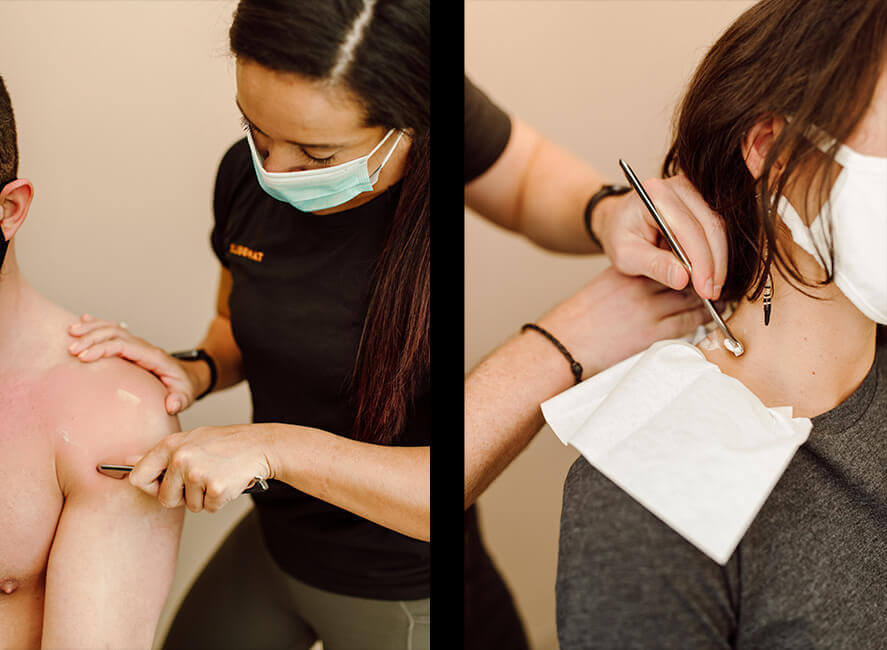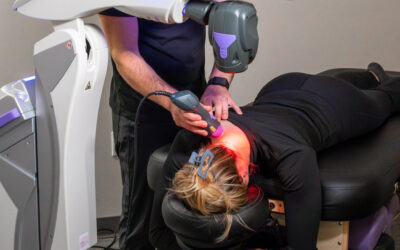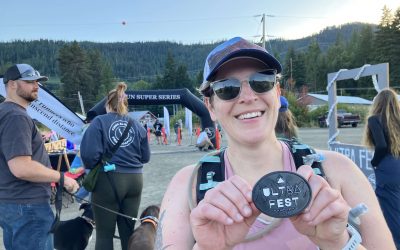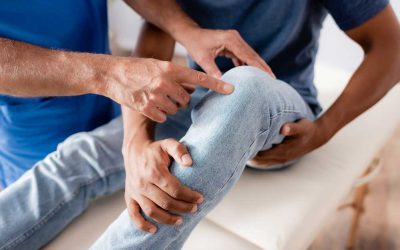In this blog post, you’ll see why Instrument Assisted Therapy or Instrument Assisted Soft Tissue Mobilization (IASTM) is so popular!
One of the most commonly performed Instrument Assisted Therapy is the Graston Technique.
The Graston Technique is a form of instrument-assisted soft tissue mobilization (IASTM), which is exactly what it sounds like.
Graston has designed different contoured instruments to assist healthcare providers and manual therapists with an efficient way to help treat soft tissue injuries or pain sites.
They may look scary (one of them looks like a crowbar!), but I assure you, they’re not meant to be extremely painful!

How does the Graston Technique work?
Graston Technique (GT) is a non-invasive, soft tissue technique that uses specially designed stainless steel instruments to help the clinician identify and treat areas of the body exhibiting soft tissue fibrosis or adhesions.
Areas of fibrosis or adhesions are thought to be found in the muscles and connective tissues with some injuries ranging from neck pain to ankle sprains.
Graston Technique allows healthcare providers to get as deep into the tissue as necessary to invoke change, yet be sensitive to patient’s pain and tolerance.
As the instruments are moved over the affected area and come in contact with the soft tissue, the action will help restore the tissue’s ability to slide over each other for normal movement and range of motion, decreasing adhesions between layers of tissue.
Some will make claims that it breaks up scar tissue, but I assure you, the only things that do that are a scalpel (surgery) and healthy movement over long periods of time.
In time, this process will reduce the adhered fibers, restoring range of motion and assisting in eliminating the associated pain. It can help transform your soft tissue injury into healthy functioning tissue.
What could you expect from your experience with Graston or other Instrument Assisted Soft Tissue Mobilization (IASTM) Therapies?
The feeling of a Graston treatment (or any other type of instrument-assisted soft tissue treatment) can be similar to a massage that is paired with some light active movement or stretching throughout.
The intensity can easily be changed to fit the pain tolerance of the patient. A typical treatment does not need to be long, with some lasting only a few minutes to get the desired effect.
As with most soft tissue issues/injuries, the treatment should be paired with some sort of exercise afterward to obtain the desired effect and help restore healthy function of the affected area.
Are there any side effects from IASTM?
Possible side effects from Graston Technique or IASTM should be minor if any.
It is normal to have some mild tenderness or redness around the affected area, but this should clear up within hours or a couple of days afterward. It isn’t abnormal to also have some minor bruising around the area, although this isn’t necessary to obtain the desired effect.
IASTM can assist in resolving conditions listed below, but isn’t limited to these:
• Achilles Tendinopathy
• Ankle sprains
• Cervical Sprain/Strain (Neck Pain)
• Lumbar Sprain/Strain (Back Pain)
• Lateral Epicondylosis/itis (Tennis Elbow)
• Medial Epicondylosis/itis (Golfer’s Elbow)
• Patellofemoral Disorders (Knee Pain)
• Plantar Fasciopathy/Plantar Heel Pain (Foot Pain)
• Rotator Cuff Tendinopathy (Shoulder Pain)
In Conclusion
In conclusion, Graston Technique, along with other instrument-assisted soft tissue techniques, can assist in a variety of injuries or issues.
We get a lot of questions, concerning the use of different household items being used for self-applied soft-tissue treatments.
These questions all come from a good place, and we’re always happy that people want to be autonomous and able to take treatment into their own hands, however, a treatment like this is best left to our trained professional at Tangelo.
Note that some of these ideas could be dangerous at home, it’s just that the outcome of the treatment (intensity, duration, pairing with appropriate exercise) are better left to a professional to steer the recovery ship in the right direction.
Are you experiencing pain after an injury or surgery or suffering from a chronic musculoskeletal condition that just does not seem to get any better?
Don’t lose hope!
Our expert team of IASTYM trained Doctors are here to serve you and get you back to living a life free of limitations. If you live in the Portland or Seattle area, don’t go one more day without hope, call us today!
“The team at Tangelo is AMAZING.
I had hip surgery in 2010 after a horsebackriding accident, and my body just hasn’t felt right since then. My low back and hip flexors get very tight and the discomfort definitely limits what I am able to do physically. I teach barre and yoga, and I was getting frustrated with myself for feeling so limited and uncomfortable in my own body.
Before going to Tangelo, I had tried acupuncture, massage therapy, and traditional chiropractic modalities. Although they all offered temporary relief, none of them seemed to address the root problem. Kinetic is different!
I love that Dr. Whitbeck utilizes different modalities (kinesiotape, active release, graston, and chiropractic adjustments), and I think that having functional rehabilitation specialists on site to guide me through PT exercises before and after the adjustments has been super helpful.
I appreciate that they send me a follow up email after each session so that I continue making progress at home in between visits. I have been going to Kinetic for a few months now, and I have definitely noticed improvements in my hip mobility and core stability.
I am looking forward to continuing to work with the Tangelo team in order to change my story!!”


